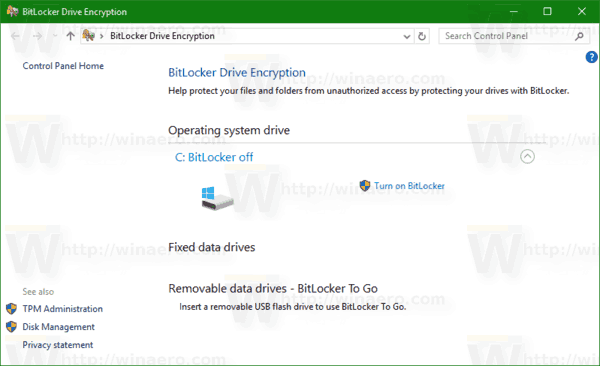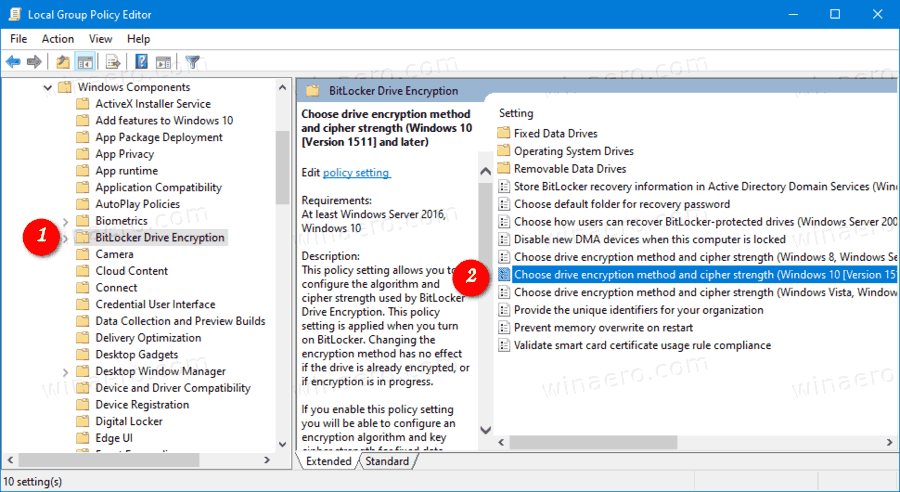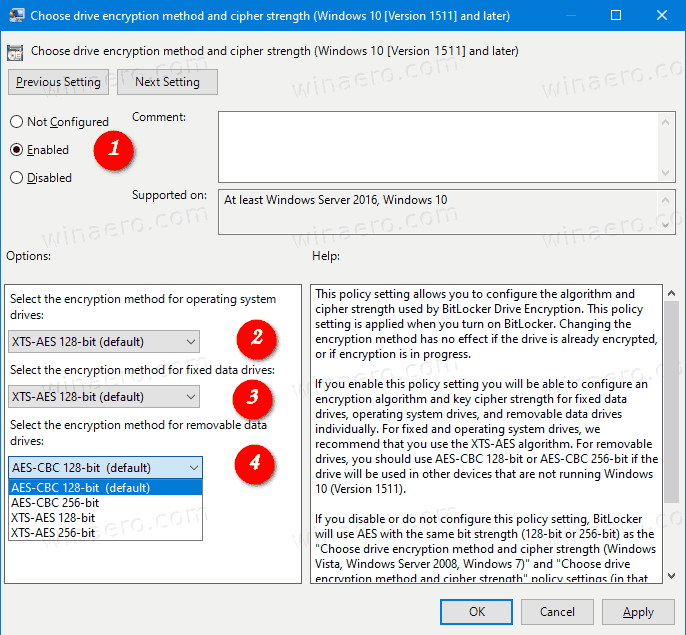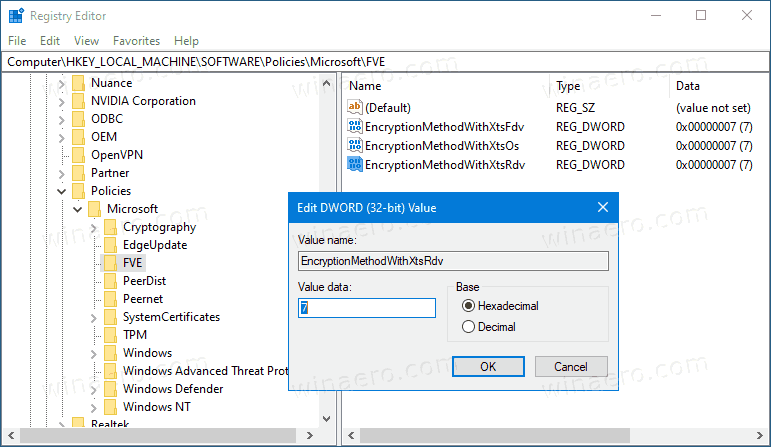How to Change BitLocker Encryption Method and Cipher Strength in Windows 10
BitLocker in Windows 10 supports a number of encryption methods, and supports changing a cipher strength. These options can be configured with either Group Policy or Registry Editor. In this post, we will review both methods.
Advertisеment

Note: In Windows 10, BitLocker Drive Encryption is only available in the Pro, Enterprise, and Education editions.
Bitlocker encryption methods and cipher strength
For fixed drives and the system drive, Windows 10 supports the following encryption methods and cipher strength:
- AES-CBC 128-bit
- AES-CBC 256-bit
- XTS-AES 128-bit ( used by default)
- XTS-AES 256-bit
For removable drives, the same encryption algorithms can be used, however, BitLocker defaults to AES-CBC 128-bit.
Here are two methods you can use to adjust the data encryption options. Please keep in mind that BitLocker applies the configured encryption method and cipher strength when you turn on BitLocker for a drive. Changing the method won't affect already encrypted drives. You have to turn off BitLocker for an encrypted drive and turn on it again to apply the new encryption options.
To Change BitLocker Encryption Method and Cipher Strength in Windows 10,
- Open the Local Group Policy editor app.
- Navigate to Computer Configuration > Administrative Templates > Windows Components > BitLocker Drive Encryption on the left.
- On the right, find the policy setting Choose drive encryption method and cipher strength (Windows 10 (Version 1511) and later).

- Double-click on it and set the policy to Enabled.
- Now, select the encryption method you want for operating system drives, fixed data drives, and removable data drives.

You are done.
Setting the mentioned policy to "Not configured' will restore defaults.
Alternatively, you can apply a Registry tweak.
Change BitLocker Encryption Method and Cipher Strength in Registry
- Open Registry Editor.
- Go to the following Registry key:
HKEY_LOCAL_MACHINE\SOFTWARE\Policies\Microsoft\FVE.
See how to jump to the desired Registry key with one click. If you do not have such a key, then just create it. - To specify BitLocker Drive Encryption Method and Cipher Strength for fixed data drives, create a new 32-bit DWORD value EncryptionMethodWithXtsFdv. Note: Even if you are running 64-bit Windows, you still need to use a 32-bit DWORD as the value type.

- Set it to one of the following values:
- 3 = AES-CBC 128-bit
- 4 = AES-CBC 256-bit
- 6 = XTS-AES 128-bit (this is the default option in Windows 10)
- 7 = XTS-AES 256-bit
- For operating system drives, create a new 32-bit DWORD value EncryptionMethodWithXtsOs.
- Set it to one of the following values:
- 3 = AES-CBC 128-bit
- 4 = AES-CBC 256-bit
- 6 = XTS-AES 128-bit (this is the default option in Windows 10)
- 7 = XTS-AES 256-bit
- For removable data drives, create a new 32-bit DWORD value EncryptionMethodWithXtsRdv.
- Set it to one of the following values:
- 3 = AES-CBC 128-bit
- 4 = AES-CBC 256-bit
- 6 = XTS-AES 128-bit (this is the default option in Windows 10)
- 7 = XTS-AES 256-bit
- To make the changes done by the Registry tweak take effect, you need to sign out and sign in again to your user account.
Later, you can delete the EncryptionMethodWithXtsRdv, EncryptionMethodWithXtsOs, and EncryptionMethodWithXtsFdv values to restore the default encryption method for all drive types.
Articles of interest:
- Encrypt VHD or VHDX File with BitLocker in Windows 10
- Deny Write to Fixed Drives not Protected by BitLocker
- Create BitLocker Drive Encryption Shortcut in Windows 10
- Deny Write to Fixed Drives not Protected by BitLocker
- Disable Write Access to Removable Disks in Windows 10
- Turn On or Off Device Encryption in Windows 10
- How To See Applied Group Policies in Windows 10
- All Ways To Open Local Group Policy Editor in Windows 10
- Apply Group Policy to All Users Except Administrator in Windows 10
- Apply Group Policy to a Specific User in Windows 10
- Reset All Local Group Policy Settings at once in Windows 10
- Enable Gpedit.msc (Group Policy) in Windows 10 Home
Support us
Winaero greatly relies on your support. You can help the site keep bringing you interesting and useful content and software by using these options:
